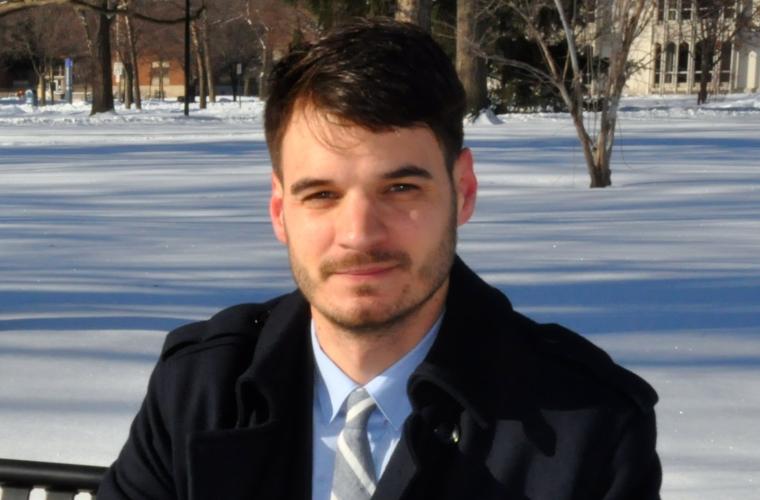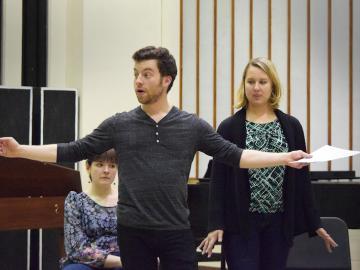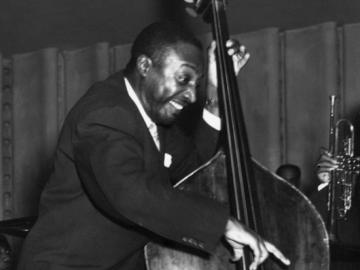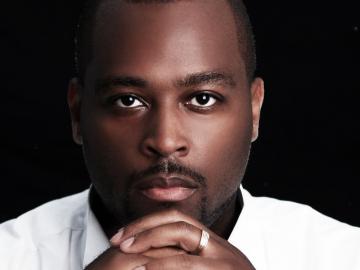Oberlin CME to Premiere Aaron Helgeson's Snow Requiem March 6
March 2, 2015
Conservatory Communications Staff

This article was written by Mike Telin ’84 for clevelandclassical.com. It is republished here with their permission.
In his book The Children’s Blizzard, author David Laskin chronicles the events of January 12, 1888. That morning the temperatures in the upper Midwest were unseasonably warm—so warm in fact that children walked to school without coats, hats, or gloves. That afternoon, one of the deadliest winter storms in U.S. history left thousands stranded as they attempted to make their way home. By the next morning, the storm had claimed more than 500 casualties, many of them schoolchildren.
This horrifying day in history is the inspiration behind composer Aaron Helgeson’s latest work. On Friday, March 6, at 8 p.m. in the Oberlin Conservatory’s Warner Concert Hall, and on Saturday, March 7, at 2 p.m. in Gartner Auditorium at the Cleveland Museum of Art, Timothy Weiss will lead the Oberlin Contemporary Music Ensemble in world-premiere performances of Helgeson’s Snow Requiem for solo violin, solo soprano, 16-voice choir, strings, percussion, and harp. The program also includes Sofia Gubaidulina’s Concerto for Bassoon and Low Strings, featuring Ben Roidl-Ward as soloist, and Jonathan Harvey’s Wheel of Emptiness.
During a conversation in his studio, Helgeson, who is a visiting assistant professor of composition at Oberlin as well as a 2005 graduate of the college and conservatory, said that the gestation of the work was quite long. “It started when I was finishing my doctoral dissertation in 2012. I felt I had mastered my toolbox in terms of composing, and I began to think about developing a project that would allow me to apply those tools to subject matter that might be of interest to people outside of the new music community. At the time, I was reading a lot of creative non-fiction, a genre that is an interest of mine, when I came across David Laskin’s book, The Children’s Blizzard.
Although Snow Requiem is not a programmatic work, Helgeson said that Laskin’s detailed writing about the event did have a direct effect on his piece. “It was a blizzard that saw wind speeds of up to 80 mph, single-day temperature drops of as much as 55 degrees fahrenheit, and snow drifts of 10-20 feet, all over the course of 8 hours.
“At the time, all of the weather forecasting was done via the Military Signal Corps, and a lot of enterprises had paid them off in order to get weather information early. Among those enterprises were the railroads, and because they had received advance notice of the storm, they shut down early, which meant that many people could not get out of the region. Most of the people in the area were Norwegian, German, and Ukrainian homesteaders, and Laskin talks about the folk music and the hymns that were sung. He also recreates the storm and the experience of the children of the people in the region. There is a particularly gruesome chapter about a group of boys who were stuck in the storm for hours, and their experiences during the different stages of hypothermia.”
While spending a few months teaching in Washington, D.C., Helgeson spent time at the National Archives researching weather data and the homesteaders, a topic that was of personal interest to him. “My great-great-grandfather came from Oslo during the Homestead Act and settled in that region, so there is a personal aspect for me. I wanted to create a project that I could really sink my teeth into, and this seemed to provide me with what I was looking for.
“Its musical unfolding is structured from temperature and wind readings taken during the storm from the weather station in Huron, South Dakota, and bookended by my own transcription of two Norwegian folk songs from the Homestead-era immigrant communities in the affected areas.”
A Norwegian folk song serves as the work’s structural base and comes from the tradition of tralling, a form of nonsense-syllable singing that is particularly prevalent in children’s music. The second folk song is a Hardanger fiddle tune that he transcribed for solo violin. The Hardanger fiddle is a violin-like instrument with sympathetic strings inside its body that resonate the notes of the bowed strings. Helgeson said it was difficult to capture the Hardanger sound in the transcription because a violin is a very different instrument, so he had to get a little creative.
“I listened to a lot of folk tunes, but I wanted to find something that captured the quality of the story. I also wanted a tune that would not be too difficult to learn linguistically if I wanted it to be performed outside of Norway. I also needed a song that I could fragment, and then harmonize in many different ways, and I thought this tralling song had a lot of possibilities. The first movement is just this folk song. And that structure is repeated during the seven movements. But as the piece progresses, the orchestra enters into the structure, and plays along with the melody and then starts to obscure it. That’s why I say it’s a collage of different sonic elements and not a program piece.”
In his informative composer’s notes about Snow Requiem, Helgeson writes: “Ultimately, this music is and isn’t a requiem. It shares similarities with previous attempts at the form (Machaut, Mozart, Brahms, Ligeti) while bearing no relation to the Catholic Mass. It has no words, yet it has a text. It is no epitaph. Rather, it’s a collage of sonic elements in proximity to the storm and those who suffered through it: the folk songs of May Hunt that kept her schoolchildren’s spirits up while they waited out the night underneath a frozen haystack they had burrowed into with their bare hands; the hypothermia-induced aural hallucinations of Peter Graber that gradually subsided as the temperature of his prairie-trapped body fell below 87 degrees; the wordless hymns of Etta Shattuck that lulled her to sleep on her deathbed weeks after being trapped in the blizzard; the deafening roar of the wind and snow as it rolled across the plains, and the even more deafening quiet that surrounded it.”
As an undergraduate at Oberlin, Helgeson also earned a BA in theater. Does his theatrical experience inform his musical compositions? “People used to say, ‘You do theater and you write music, so you must write musicals.’ At first it wasn’t easy to reconcile the two. But as I’ve learned more about myself as a composer I’ve discovered that, yes, actually, the theater really has influenced a lot of what I do musically, even though it might not be obvious on the surface. If you think of the sounds as characters you can say, 'OK, what can they do in terms of their relationships to one another: this one starts a phrase, This one continues it, and this one stops it. And they’re not arbitrary—they’re based on who this character is.'”
He also admits that he is, and always has been, interested in sound. “I grew up in Eugene, Oregon, and when we’d go camping I just loved sitting and listening to every little sound and imagining what it would be like to add this or that little sound to it. I think listening is a big part of what I do as a composer, which is one of the reasons why I really wanted to incorporate transcriptions into this piece. It affords me the opportunity to really listen to something that I’m not a native in. So this was one way of getting to know music that I have connections to but that I am not as familiar with.”
Snow Requiem represents the culmination of many things in Helgeson’s personal and musical life. “The more I learn about Norway, the more I feel like I need to go there. I haven’t made my pilgrimage yet, so this is maybe a way of doing that. Spending time at the Archives was great, and of course they have all sorts of immigration records, so I did find out a lot of information about my family.”
This article was originally published February 24, 2015.
Tags:
You may also like…
Jason Goldberg '16 Leads Oberlin Co-Production of Dido and Aeneas
April 5, 2016
Milt Hinton Institute Returns with Emphasis on Suzuki Instruction
March 31, 2016
Baritone Michael Preacely '01 to Perform, Lead Talks at Oberlin
March 17, 2016


